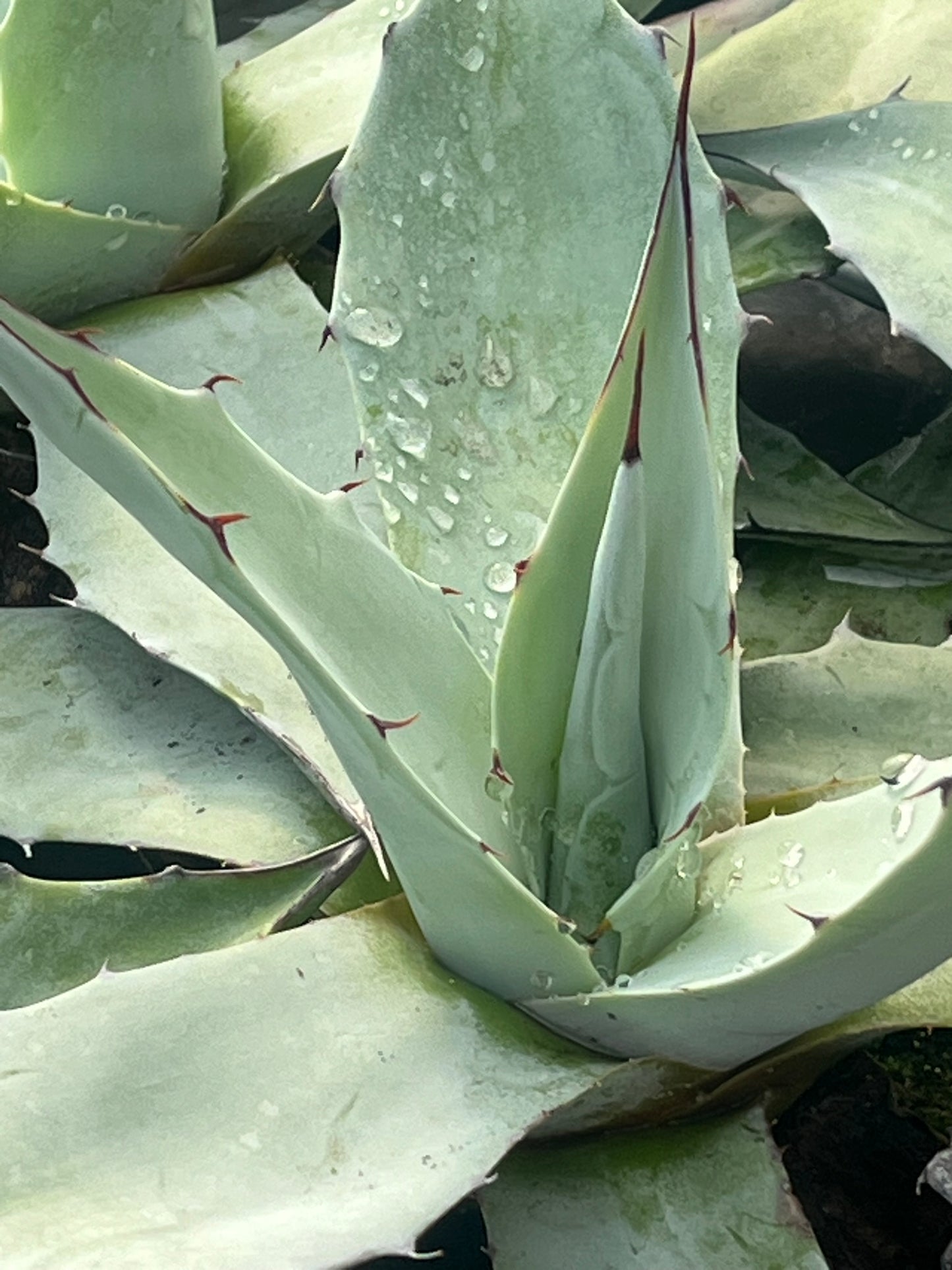Plant Hoarder
Agave, Frosty Blue
Agave, Frosty Blue
Couldn't load pickup availability
Share
Hardiness Zone:7, 8, and 9
Sun Exposure:Full Sun
Agave ‘Frosty Blue’
Bold Beauty. Cool Color. Easy Care.
If you're looking for a plant that’s equal parts rugged, refined, and radiant—Agave ‘Frosty Blue’ is your dream come true. This architectural beauty is one of the most striking agaves you can grow. With powdery blue leaves edged in subtle teeth and arranged in a perfect rosette, it looks like a living sculpture straight out of the desert. But the best part? It’s as tough as it looks—drought-tolerant, heat-loving, and nearly carefree once established.
Let’s walk through what makes this plant special, how to grow it, and how to help it thrive for years to come.
🌿 What Is Agave ‘Frosty Blue’?
Agave ‘Frosty Blue’ is a medium to large-sized agave with glowing silvery-blue leaves. It’s a cultivar of Agave franzosinii or sometimes noted as a selection of Agave americana. This agave is known for its cool-toned foliage that practically shines under sunlight.
Each leaf is thick, sword-shaped, and arranged in a symmetrical rosette that can reach up to 4–6 feet tall and wide at maturity. The leaf tips come to a sharp point, and the edges may have small spines—so give it space to shine without brushing against walkways.
But most of all, what people love about this plant is the icy blue tone that brings elegance and contrast to any garden.
☀️ Light: Let the Sunshine In
Agave ‘Frosty Blue’ absolutely loves the sun.
-
Full Sun is ideal—at least 6 hours per day.
-
It can tolerate light shade, especially in very hot climates, but the blue color shines brightest in strong sunlight.
-
Indoors, give it the brightest possible spot, like a south-facing window or a sunny patio.
Sunlight keeps its leaves compact, its color vibrant, and its form tight.
🌵 Soil: Sharp Drainage Is Key
This is a desert native at heart. That means it wants well-draining soil, and lots of it.
-
Use a cactus or succulent mix, or make your own by mixing regular potting soil with coarse sand, pumice, or perlite.
-
Avoid soggy soil at all costs. Roots sitting in wet soil will rot.
If planting in the ground, amend heavy clay or loamy soil with sand or gravel.
💧 Watering: Less Is More
One of the best things about Agave ‘Frosty Blue’? Low water needs.
-
Water deeply but infrequently. Let the soil dry out completely before watering again.
-
In summer, this might mean watering every 10–14 days. In winter, water even less—once a month or less is often enough.
-
If it’s in a container, make sure the pot has a drainage hole.
Overwatering is the number one killer of agaves. When in doubt, wait a day or two.
🌡️ Temperature & Hardiness
Agave ‘Frosty Blue’ is both heat-tolerant and cold-hardy—to a point.
-
Hardy to around 15–20°F (-6 to -9°C) once mature and established.
-
In colder zones (below USDA Zone 8), grow it in containers that can be moved indoors during winter freezes.
-
It thrives in USDA Zones 8b to 11 in the ground.
Give it protection from frost when young or potted.
🪴 Container Growing Tips
If you’re short on space or live in a cooler climate, Agave ‘Frosty Blue’ is a fantastic container plant.
-
Choose a large, heavy pot with a drainage hole.
-
Use fast-draining soil and place in a sunny spot.
-
Water sparingly and move indoors when frost threatens.
Pro tip: Use a terra cotta or concrete pot to prevent tipping—this plant gets top-heavy!
✂️ Maintenance: Practically None
Agave ‘Frosty Blue’ is about as low-maintenance as it gets.
-
No need to fertilize more than once or twice per year—a diluted cactus fertilizer in spring is plenty.
-
Remove any dead or damaged leaves by cutting them cleanly at the base.
-
Watch for pups (offsets) at the base—these can be left alone or separated and replanted.
It grows slowly, so you won’t need to prune or re-pot often.
🌸 Will It Bloom?
Yes—but only once in its lifetime.
Agave ‘Frosty Blue’ is monocarpic, meaning it blooms once and then dies. This usually happens after 10–15 years, sometimes longer.
When it does bloom, it sends up a massive flower stalk—up to 15 feet tall! The flowers are usually yellow and are a beacon for pollinators.
After flowering, the mother plant dies—but not before producing pups at the base to carry on the legacy.
🐜 Pests & Problems
Agaves are pretty pest-free, but here’s what to watch for:
-
Agave Snout Weevil – a serious pest that bores into the core. If your agave suddenly collapses or rots from the center, this might be the cause.
-
Root Rot – caused by too much water or poorly draining soil.
-
Occasionally, mealybugs or scale insects may appear. Treat with neem oil or insecticidal soap.
Healthy plants grown in dry, sunny conditions rarely suffer from major problems.
🌿 Where to Use It
Agave ‘Frosty Blue’ is incredibly versatile in the landscape:
-
Use it as a focal point in dry gardens or xeriscapes.
-
Pair it with ornamental grasses, yucca, or desert wildflowers.
-
Great for rock gardens, cactus beds, or even modern minimalist gardens.
-
In containers, it makes a dramatic patio feature.
Its soft blue color contrasts beautifully with greens, reds, and silvers.
💙 Why Gardeners Love It
Here’s why Agave ‘Frosty Blue’ keeps winning hearts:
-
Stunning cool-toned color
-
Bold, architectural shape
-
Tough and drought-tolerant
-
Excellent in pots or in-ground
-
Practically no maintenance
This plant doesn’t ask for much, but it gives back in spades—with structure, texture, and drama that lasts all year long.
So if you’re dreaming of a low-effort, high-impact addition to your garden or patio, Agave ‘Frosty Blue’ is ready to shine. Give it sun, space, and time—and let this frosty beauty do what it does best: stand tall, look cool, and thrive without fuss.


